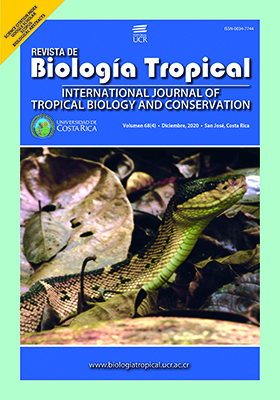Abstract
Introduction: Coastal lagoons are important habitats for coastal fishes playing an essential role as nursery areas for many species. While the effects of salinity and temperature on fish abundance spatial and temporal variation have been well documented, research on the influence of substrate characteristics is scarce. Objective: To investigate the correlation of salinity, temperature and sediment characteristics with spatial and temporal variations of the ichthyofauna composition in Barra de Navidad coastal lagoon´s shallow zones. Methods: Samples of ichthyofauna were taken with a beach purse seine along a period of two years in four sites. Water salinity and temperature were measured simultaneously with fish sampling operations. Sediment particle size and organic matter content were determined four times at each site during the sampling period. Multivariate methods were used for data analyses. Results: A total of 13 487 fish pertaining to 69 species were collected, but only five taxa (Eucinostomus currani, Mugil setosus, Anchoa sp., Diapterus brevirostris, Centropomus robalito) made up more than 80 % of the individuals. Significant differences among all sampling sites and between seasons were found for the ichthyofauna composition. Redundancy analysis showed that changes in ichthyofaunal composition were mainly related to the percentage of mud and organic matter in sediments expressing a spatial gradient. The influence of salinity and temperature was also significant, but these variables explained a smaller proportion of the observed variability and were related mainly to seasonal changes. Conclusions: Sediment particle size and organic matter content are the most important abiotic factors influencing spatial changes in shallow water ichthyofaunal composition. Seasonal changes were correlated with changes in salinity and temperature but could also be related to biological processes such as reproduction and recruitment.
##plugins.facebook.comentarios##

This work is licensed under a Creative Commons Attribution 4.0 International License.
Copyright (c) 2020 Yureidy Cabrera-Paez, Consuelo M. Aguilar-Betancourt, Gaspar González Sansón



